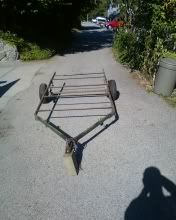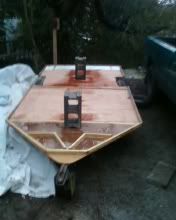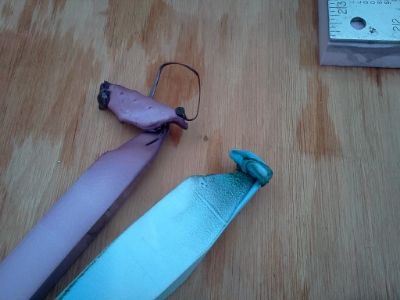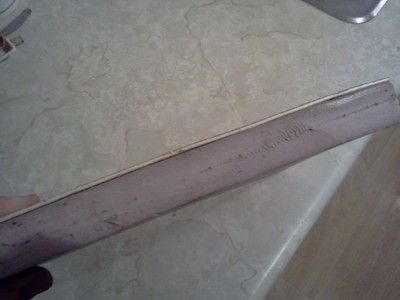- Good Sam Community
- Everything RV
- DIY Maintenance
- The Ultimate DIY thread - Ubuilding (Pics)
- Subscribe to RSS Feed
- Mark Topic as New
- Mark Topic as Read
- Float this Topic for Current User
- Bookmark
- Subscribe
- Mute
- Printer Friendly Page
The Ultimate DIY thread - Ubuilding (Pics)
- Mark as New
- Bookmark
- Subscribe
- Mute
- Subscribe to RSS Feed
- Permalink
- Report Inappropriate Content
Mar-04-2012 10:52 AM
There is another, albeit smaller, side to this whole RV thing - those crazy folks who build their own for whatever reason. Whether you've scratch-built it from the ground up, assembled a kit, or (like me) scrounge up appropriate frames and go from there: let's hear about it.
I'm on number three.
The first was simply a utility trailer that got an enclosed box for a fraction of the cost of the used toy haulers I was looking at. It was carrying mountain bikes and race gear, so the GVW didn't matter and all the commercially built units were overkill for what I needed. A guy my dad worked with had a dump trailer he didn't need anymore...and so it began.
Number two was a more adventurous project. I started with a tent trailer deck and built a steel stud frame and sheathed it, first in OSB then in 1/4" ply when that failed dismally. I camped the trailer as a bare shell a few times, but the noise when the wind blew wasn't conducive to a good night's sleep. It's still on my 'ideas' pile, but it wold have to be FAR more rigid than that 'technology demonstrator' was.
Those two were pre-internet and pre-digital (for me at least) so there are pics but they are in a box in the basement and haven't seen the light of day in a long time...lost at sea.
Then I got a great deal on a 24' 1977 Dodge C..."had I known then what I know now..." nuff said.
That was how I found this forum.
A couple other projects and work since then and now I'm at a stage in my life where I want to go back to school and get the education I should have gotten years ago. Part of that 5 year strategy is staying in a trailer to keep my accommodation costs down....the rub is that I drive a compact pickup and don't have said trailer.
For this boatbuilder, the solution was a cinch...
My principal build requirements have been low build cost, low towing weight, four season (no canvas) and a permanent bed.
So far, I am building to all of those except for a minor concession in the bed - it will convert to form one side of the dinette.
I started with a tent trailer - $50 on craigslist. Once the body was off, the build could begin:

The deck is a sandwich of 3/8 ply, 1" foam, and 1/8 doorskin on top to provide some puncture resistance. At the moment, I'm sheathing the top of the deck in epoxy and 6oz cloth (pics to follow). The body will be foam and epoxy and will be shaped like a horse trailer - the head will be u in the nose and the bed will be in the back with a slide out in the back wall for a footwell. I will have to fab the (manual) slideout mechanism. My plan is to use heavy duty drawer slides, but any insight there is appreciated.
This is the completed but not yet glassed deck:
 .
.For the appliances, I scrounged up a free camper on craigslist. For the cost of a case of beer and the dump fees ($60), I got a stove/oven, two way fridge, lantern, windows, and a bunch of other bits. I still have to replace the heating element in the fridge (works great on gas) and the furnace valve body was beyond my desire to fix it, but otherwise everything works great and just needs to be cleaned up a bit.
Today, I'll be glassing the rest of the deck and next weekend I'll start assembling the cabinet carcasses and bulkheads. I was going to get the shell done first (the way you build a house) but the overhang off the back will be easier to build if I have the bed framing in place first. All will be built with 1" foam and then glassed. I haven't decided to make a weight concession with the galley countertop and dinette table and go with 3/4" ply or to use foam with an upper skin of 1/4" ply. Either way, they will be small enough that I can make both from the leftovers.
That's my build to date...let's hear about yours !
- Mark as New
- Bookmark
- Subscribe
- Mute
- Subscribe to RSS Feed
- Permalink
- Report Inappropriate Content
Mar-19-2013 05:32 PM
DeadeyeLefty wrote:recycler wrote:
coleman stovetop oven
Like one of these guys ?
For $50, even if I don't like it I'm sure I could turn it into a smoker...
:S Oh no, I forgot to incorporate the smoker into the build !! (lol)
free radical, thanks for checking in. I'm posting on the run right now, but when I get a bit of time I'll post up test results and some pics. That includes burn tests because hey, who doesn't love destructive testing ?
:B
yep one of those.. when your power center is were the oven used to be 😞 one has to make do.. i like the idea of turning it to a smoker if it does not work.. salmon would be good..
- Mark as New
- Bookmark
- Subscribe
- Mute
- Subscribe to RSS Feed
- Permalink
- Report Inappropriate Content
Mar-19-2013 05:20 PM
http://youtu.be/U_7nMphB6JY
- Mark as New
- Bookmark
- Subscribe
- Mute
- Subscribe to RSS Feed
- Permalink
- Report Inappropriate Content
Mar-19-2013 08:40 AM
- Mark as New
- Bookmark
- Subscribe
- Mute
- Subscribe to RSS Feed
- Permalink
- Report Inappropriate Content
Mar-19-2013 07:11 AM
I'm guessing they are making them very sensitive, now.
You know, I've run across the same thing in boats - at least with 12V ones you can pull the fuse. I'd guess it has to do with the smaller volume of the 'room' it's sampling, but I don't know that for certain. That said, I'll trade the odd nuisance alarm for being able to sleep easier.
Agreed on the cocoon's efficiency: combined with how well sealed it will be, getting rid of the humidity will be a bigger problem I think but I'm providing for both active and passive ventilation. I want to try weatherstripping the jalousie slats with thin foam tape, but overall I think a certain amount of heat loss is a good thing because that's also water vapour that's escaping...the trick is to maintain that perfect balance in all seasons without a dedicated heating appliance, and with LPG which gives off moisture of its own.
- Mark as New
- Bookmark
- Subscribe
- Mute
- Subscribe to RSS Feed
- Permalink
- Report Inappropriate Content
Mar-19-2013 04:10 AM
It is amazing how little heat is needed when you have a shell of foam around you. I think you'll find that heating your cocoon will be very efficient.
'71 Starcraft Wanderstar -- The Cowboy/Hilton
- Mark as New
- Bookmark
- Subscribe
- Mute
- Subscribe to RSS Feed
- Permalink
- Report Inappropriate Content
Mar-18-2013 09:48 PM
"westend" wrote:
Remember, no smoking meat with leftover extruded poly
Sssshhhh, cyanide gas was the 'secret ingredient' in Grandpa's brine recipe....
Okay, sorry for the long one here but I tried to answer questions in as much detail as I could so you can see how I came to the design I did. At least I peppered it with pics and even a video (dial up users: apologies!)
free radical wrote:
I did it from plywood coated with epoxy instead.
Nothing wrong with that - wood is the original composite and is an amazing material to build with. Epoxy's compatibility with it made it possible for anyone with only moderate skill to build a boat (or an RV!). Part of the reason I'm enjoying this is that it gives me the chance to try out different ideas and techniques than I get to in my paid gig and because I've always gotten a kick out of all the different things you can do with glass simply by varying the layup a little.
Unfortunately, that's at a cost for me too: that's the only reason the build is going so slowly. I could go out tomorrow and by 2X2's and 1/4" ply and be camping in a month of weekends, or just go and buy a small TT, but I'm building for the sake of the build.
Who would have guessed that it took so darn many beer to build a little trailer though ? :B
"TachDriver" wrote:
Where were you when I was rebuilding my fiberglass boat? lol.
Let me guess, replacing rotten wooden stringers or transom core ?
Done waaay too many of those - I feel your pain.
"free radical" wrote:
Wondering how strong is this type of structure, have you done any tests on how much weight can the roof withstand?
"TachDriver" wrote:
...will you be using stringers and ribs to support the ceiling?
As far as the roof structure goes, I do have a transverse stringer to carry the weight of the front of the solar array (such as it is) to the outer walls. The rest of that load will be carried by the back wall. From there, the roof begins to camber up the the vent. The curb for the vent is glassed as well, since it will form a load ring with unidirectional fabric in the layup. I'll have about 60# (IIRC) of solar up on the roof and, even if I wanted a luggage rack up there, there's no room - this is only a 13' trailer overall. The majority of the loading will actually be from the trailer trying to flex as it goes down the road, unlike a build from individual members (like studs and trusses) where the walls hold up the roof.
I'm trying to build it as much of a true monocoque structure as I can. By using inner and outer skins of glass held a fixed distance apart by the foam, the two skins working against each other can carry insane amounts of load in proportion to the weight of the materials. The added plus is that the materials themselves are light enough that they don't add much loading. That said, there is one full height bulkead where the 'nose cone' starts and lower cabinetry that will contribute to the stiffness. I'm debating whether or not to glass the tanks in or not as well: they will add to the stiffness but may also flex, compromising the joints. Regardless, that decision is a long way down the road yet.
I wanted to create what was essentially an egg-within-an-egg. I had several reasons for canting the upper and lower corners of the sidewall back in toward the frame, one of which was to help carry vertical roof loads (solar panels, snow) to the frame. A benefit of this shape was that the corners help to stiffen the sidewalls as well. With the heavier layup over corners and seams I am providing 'bands' that make up a grid. Given how strong the matrix is in compression, that means essentially a cage made up of intersecting rings if one were to envision it without the foam. From a structural standpoint, the foam is there to keep the 'bands' locked together so they can't deform.
This is how most performance composites start out, but I have severely scaled it down to something that I can do in the space I have and within my budget (such as it is, lol).
That de-rating is exactly why I started with testing...
Some of the first tests I did were of the bond between the glass skin and the foam, and a combustion test. I learned some interesting things from each that may seem counter intuitive. The former is back on the first couple pages, the deflection testing was done the same way I did for the door panel.
"free radical" wrote:
...since this stuff is so flammable,if you plan on cooking inside is to carry TWO fire extinguishers...
You know, I thought long and hard about ever using this stuff for that very reason. One of the things I learned is that there is a different fire rating for US vs Canadian products: the US version has an exterior fire retardant coating that Canadian products don't. Apparently that's in part because under code in the US you can use it in far more places than you can in Canada. That said, it depends on whether the store has sourced it domestically or not. I looked for a scrap of the US stuff tonight that I could burn, to be sure I was comparing apples to apples, but it got too dark out back.
Here are a couple pieces of the first test I did (made in US product):

The foam melted and burned with open flame only as long as the heat (torch) was on it. **I'll replace the pic with a video after I poke through the scrap foam pile**
Here's a short video clip of the made in Canada stuff. It still takes a bit to get going, but it does support combustion. As you can see, it didn't take much to put it out.
I'm not saying anything because you wouldn't be able to make it out through the mask...
My concern is not just about open fire, but the smoke that the foam gives off is a thick acrid cloud that I imagine would incapacitate one pretty quickly so egress is my primary concern rather than fighting a fire. The compination, epoxy and paints is a toxic soup that you don't want to be breathing while you're trying t put out a fire.
Because the combustion appliances are all between the bed and the door, the back window has panes big enough to crawl through. They are old single pane jalousie windows, so in a pinch they will make a hole big enough to get out through. I am also toying with the idea of a swing-out frame like on a bus.
I'm allowing all kinds of clearance around the stove and the forward bulkhead will be lined with plywood and metal. If I can't find an appliance carcass at the scrap yard to cut a couple pieces of white enameled steel from (or maybe even stainless), I'll use something like aluminum flashing - the point is that there will be metal flashing to keep anything that's actively burning contained on the stove top.
Where the oven vent comes up at the back of the stove, I have about 4" of space to the outer wall. That space will serve as a thermal break between the steel and inside of the outer wall. If you look at the picture of the countertop, that's the skinny part of the L at the back of the stove cutout.
After I cleaned and tested the stove, I found that, with the oven at 300 degrees (measured), the outside of the sides were just on the verge of being uncomfortable to touch after 1/2 hour. Based on the testing I did of the laminate, upping the 1/8 ply to 1/4" and using metal rather than laminate should more than protect the foam core.

Epoxy softens at 100 degC, so 80 is about the limit. If testing shows that to be inadequate, the plan is to float the steel on top of some rockwool firestop, but that will thicken the bulkhead at least an inch which I want to avoid...but not at the expense of safety.
As far as the actual safety equipment is concerned, I am planning on having 2 2-1/2 BC extinguishers aboard: one at the bed and one at the door.
There will also be a smoke detector at the ceiling and a CO monitor below the level of the bed. I recently saw a hard-mount kitchen extinguisher that one mounts above the stove for flash fires but I haven't checked them out yet (Kidde, I think?) I get all that stuff cheap through work so it just makes sense to use it.
One upgrade down the road is a gas sniffer in the toe kick and shutoff solenoid at the tank. I've put a bunch of Fireboy S2 kits in boats and they seem to be pretty reliable.
All that being said, most of the cooking will likely be done outside under an awning because, with how well insulated this thing is, it will get pretty warm in there. I'll pack a folding table and a cookstove, and we'll have the outside bevvie cooler but am still building as though all the cooking will be done inside. I will also be installing a wall mount gas lantern over the table, as much for heat as for light. I am blown away that, even seams between glassed and unglassed panels, no window in the door, and open wheel wells, a propane lantern heats the interior from around freezing to T-shirt comfort in about an hour. That will drop as I replace foam with glass and due to the ventilation needed to deal with the humidity but it bodes well for warmth. Besides, my wife and I and our 70lb Golden will probably warm it up pretty quickly too 🙂
- Mark as New
- Bookmark
- Subscribe
- Mute
- Subscribe to RSS Feed
- Permalink
- Report Inappropriate Content
Mar-18-2013 08:37 PM
DeadeyeLefty wrote:Nice, I may have to pick up one of them, too! There is no sense in a man having to wait for a second tray of biscuits.recycler wrote:
coleman stovetop oven
Like one of these guys ?
For $50, even if I don't like it I'm sure I could turn it into a smoker...
:S Oh no, I forgot to incorporate the smoker into the build !! (lol)
free radical, thanks for checking in. I'm posting on the run right now, but when I get a bit of time I'll post up test results and some pics. That includes burn tests because hey, who doesn't love destructive testing ?
:B
Remember, no smoking meat with leftover extruded poly. It smokes good but leaves the meat too dark.
'71 Starcraft Wanderstar -- The Cowboy/Hilton
- Mark as New
- Bookmark
- Subscribe
- Mute
- Subscribe to RSS Feed
- Permalink
- Report Inappropriate Content
Mar-18-2013 06:15 PM
Where were you when I was rebuilding my fiberglass boat? lol.
- Mark as New
- Bookmark
- Subscribe
- Mute
- Subscribe to RSS Feed
- Permalink
- Report Inappropriate Content
Mar-18-2013 05:38 PM
recycler wrote:
coleman stovetop oven
Like one of these guys ?

For $50, even if I don't like it I'm sure I could turn it into a smoker...
:S Oh no, I forgot to incorporate the smoker into the build !! (lol)
free radical, thanks for checking in. I'm posting on the run right now, but when I get a bit of time I'll post up test results and some pics. That includes burn tests because hey, who doesn't love destructive testing ?
:B
- Mark as New
- Bookmark
- Subscribe
- Mute
- Subscribe to RSS Feed
- Permalink
- Report Inappropriate Content
Mar-18-2013 05:33 PM
I was considering building my TC the same way but the cost of materials stopped me,and I did it from plywood coated with epoxy instead.
Wondering how strong is this type of structure,
have you done any tests on how much weight can the roof withstand?
only thing I would suggest,since this stuff is so flammable,if you plan on cooking inside is to carry TWO fire extinguishers,just in case,,
good luck and keep posting its very interesting to see these kinds of different designs..
- Mark as New
- Bookmark
- Subscribe
- Mute
- Subscribe to RSS Feed
- Permalink
- Report Inappropriate Content
Mar-18-2013 01:25 PM
- Mark as New
- Bookmark
- Subscribe
- Mute
- Subscribe to RSS Feed
- Permalink
- Report Inappropriate Content
Mar-17-2013 09:18 PM
Hey westy, thx.
I had thought about mounting the fridge up high like in yours (and most), but I'd have to give up the skylight corner windows to box it in. There just wasn't the room to put it underneath the counter and I didn't want to sacrifice the queen bed either, so a stowaway cooler it is.
I hear ya on the biscuits: some strong back coffee, a farmer breakfast in the cast iron and a pan of biscuits fresh out of the oven.
I'm drooling already...
- Mark as New
- Bookmark
- Subscribe
- Mute
- Subscribe to RSS Feed
- Permalink
- Report Inappropriate Content
Mar-17-2013 08:42 PM
'71 Starcraft Wanderstar -- The Cowboy/Hilton
- Mark as New
- Bookmark
- Subscribe
- Mute
- Subscribe to RSS Feed
- Permalink
- Report Inappropriate Content
Mar-17-2013 01:29 PM
2013 Forest River 3001W Windjammer
Equilizer Hitch
Honda EU2000
"I have this plan to live forever; so far my plan is working"
- Mark as New
- Bookmark
- Subscribe
- Mute
- Subscribe to RSS Feed
- Permalink
- Report Inappropriate Content
Mar-17-2013 07:48 AM
Yeah, I've had to make a few compromises from where I originally started, but I don't think it's anything we can't live with. I too had thought about just going with a cooktop rather than an oven, but we will likely be among the few who actually use the oven.
I'm hoping to get at least one trip out of it this summer but life has been getting in the way 🙂





